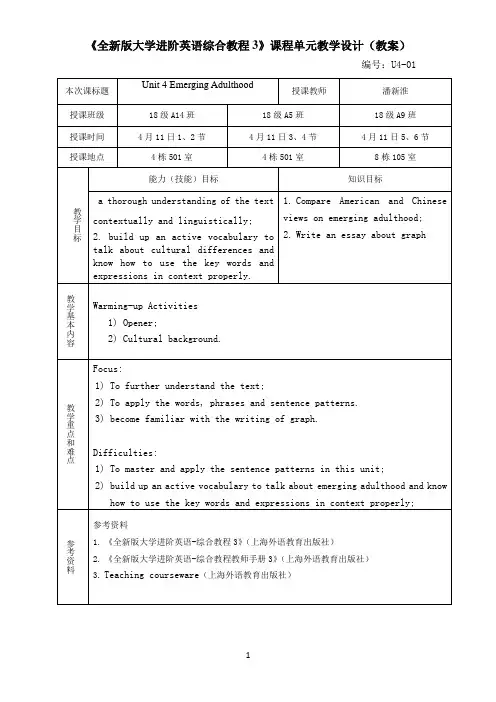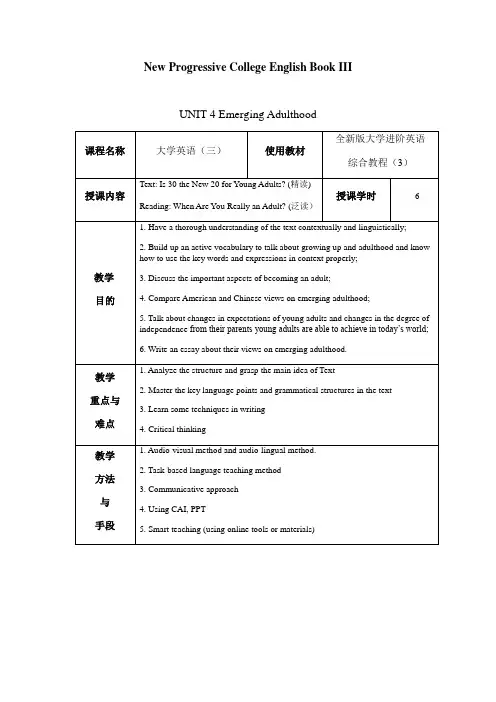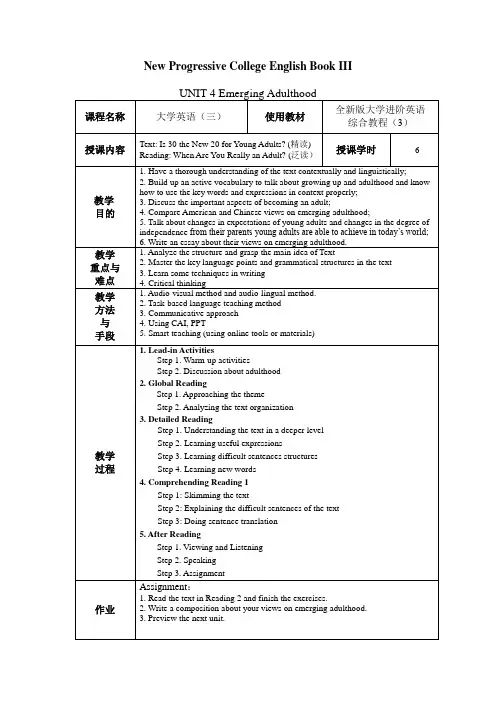《全新版大学进阶英语综合教程3》Unit-4教案
- 格式:docx
- 大小:40.68 KB
- 文档页数:24





New Progressive College English Book III UNIT 4 Emerging Adulthood1. Teaching Objectives:Students will be able toA. have a thorough understanding of the text contextually and linguistically;B. build up an active vocabulary to talk about growing up and adulthood and know how to usethe key words and expressions in context properly;C. discuss the important aspects of becoming an adult;D. compare American and Chinese views on emerging adulthood;E. talk about changes in expectations of young adults and changes in the degree ofindependence from their parents young adults are able to achieve in today’s world;F. write an essay about their views on emerging adulthood.2. Time Allotment:1st Period: Lead-in Activities (Warm-up activities; Discussion about adulthood)2nd Period: Global Reading (Text: Approaching the theme; Analyzing the text organization)3rd Period: Detailed Reading (Understanding the text in a deeper level; Analyzing difficult sentence structures)4th Period: Detailed Reading Continued (Learning new words; Summarizing good usage)5th Period: Comprehending Reading 1 (Skimming the text; Explaining the difficult sentences of the text; Doing sentence translation))6th Period: After Reading (Viewing and listening; Speaking; Assignment)3. Teaching Procedures:3.1 Lead-in ActivitiesStep 1. Warm-up activitiesThe teacher leads students to figure out the five stages of life (infancy, childhood, adolescence, adulthood and old age) and tells them a new life stage “emerging adulthood”has been proposed by psychologists to describe the period of time between adolescence and adulthood..Method: PPT, communicative approach.Step 2: Discussion about adulthoodThe teacher has students work in pairs and discuss the questions in Opener about their own criteria for reaching adulthood. The teacher reminds students to refer to the helpful words and expressions given below the pictures.Method: Using task-based language teaching method, communicative approach.3.2 Global ReadingStep 1. Approaching the themeThe teacher has students know the background information about the term “emerging adulthood” in Culture Notes.Emerging Adulthood: Starting in 1995, psychologist Jeffrey Jensen Arnett interviewed 300 young people aged 18 to 29 in cities around the nation over five years, asking them questions about what they wanted out of life. Working from those interviews and examining broad demographic indicators, Arnett proposed a new period of life-span development he calls “emerging adulthood”.从1995年开始,历时5年,心理学家杰弗里·阿内特在美国许多城市访谈了300位18-29岁的年轻人,就他们想从生活中得到什么进行提问。

New Progressive College English Book III1. Teaching Objectives:Students will be able toA. have a thorough understanding of the text contextually and linguistically;B. build up an active vocabulary to talk about growing up and adulthood and knowhow to use the key words and expressions in context properly;C. discuss the important aspects of becoming an adult;D. compare American and Chinese views on emerging adulthood;E. talk about changes in expectations of young adults and changes in the degreeof independence from t heir parents young adults are able to achieve in today’s world;F. write an essay about their views on emerging adulthood.2. Time Allotment:1st Period: Lead-in Activities (Warm-up activities; Discussion about adulthood) 2nd Period: Global Reading (Text: Approaching the theme; Analyzing the text organization)3rd Period: Detailed Reading (Understanding the text in a deeper level; Analyzing difficult sentence structures)4th Period: Detailed Reading Continued (Learning new words; Summarizing good usage)5th Period: Comprehending Reading 1 (Skimming the text; Explaining the difficult sentences of the text; Doing sentence translation))6th Period: After Reading (Viewing and listening; Speaking; Assignment) 3. Teaching Procedures:3.1 Lead-in ActivitiesStep 1. Warm-up activitiesThe teacher leads students to figure out the five stages of life (infancy, childhood, adolescence, adulthood and old age) and tells them a new life stage “emerging adulthood” has been proposed by psychologists to describe the period of time between adolescence and adulthood..Method: PPT, communicative approach.Step 2: Discussion about adulthoodThe teacher has students work in pairs and discuss the questions in Opener about their own criteria for reaching adulthood. The teacher reminds students to refer to the helpful words and expressions given below the pictures.Method: Using task-based language teaching method, communicative approach.3.2 Global ReadingStep 1. Approaching the themeThe teacher has students know the background information about the term “emerging adulthood” in Culture Notes.Emerging Adulthood: Starting in 1995, psychologist Jeffrey Jensen Arnett interviewed 300 young people aged 18 to 29 in cities around the nation over five years, asking them questions about what they wanted out of life. Working from those interviews and examining broad demographic indicators, Arnett proposed a new period of life-span development he calls “emerging adulthood”.从1995年开始,历时5年,心理学家杰弗里·阿内特在美国许多城市访谈了300位18-29岁的年轻人,就他们想从生活中得到什么进行提问。

WORD格式课程名称授课内容教学目的教学重点与难点教学方法与手段教学过程作业New Progressive College English Book IIIUNIT 4 Emerging Adulthood大学英语(三)使用教材全新版大学进阶英语综合教程( 3)Text: Is 30 the New 20 for Young Adults?( 精读 )授课学时 6Reading: When Are You Really an Adult? ( 泛读)1.H ave a thorough understanding of the text contextually and linguistically;2.B uild up an active vocabulary to talk about growing up andadulthood and know how to use the key words and expressions incontext properly;3.D iscuss the important aspects of becoming an adult;4.C ompare American and Chinese views on emerging adulthood;5.T alk about changes in expectations of young adults and changes in the degree of independence from their parents young adults are able to achieve in today ’ s w6.W rite an essay about their views on emerging adulthood.1.A nalyze the structure and grasp the main idea of Text2.M aster the key language points and grammatical structures in the text3.L earn some techniques in writing4.C ritical thinking1.A udio-visual method and audio-lingual method.2.T ask-based language teaching method3.C ommunicative approach4.U sing CAI, PPT5.S mart teaching (using online tools or materials)1. Lead-in ActivitiesStep 1. Warm-up activitiesStep 2. Discussion about adulthood2. Global ReadingStep 1. Approaching the themeStep 2. Analyzing the text organization3. Detailed ReadingStep 1. Understanding the text in a deeper levelStep 2. Learning useful expressionsStep 3. Learning difficult sentences structuresStep 4. Learning new words4.C omprehending Reading 1Step 1: Skimming thetextStep 2: Explaining the difficult sentences of the textStep 3: Doing sentence translation5.A fter ReadingWORD格式Step 1. Viewingand ListeningStep 2. SpeakingStep 3.AssignmentAssignment:1.R ead the text inReading 2 andfinish theexercises.2.W rite acomposition aboutyour views onemerging adulthood.3.P review the nextunit.Unit 4Emerging Adulthood1. Teaching Objectives:Students will be able toA. have a thorough understanding of the text contextually and linguistically;B. build up an active vocabulary to talk about growing up and adulthood and know how to usethe key words and expressions in context properly;C. discuss the important aspects of becoming an adult;D. compare American and Chinese views on emerging adulthood;E. talk about changes in expectations ofyoung adults and changes inthe degree of independence from their parents young adults are able to achieve in today ’ sworld;F. write an essay about their views on emerging adulthood.2. Time Allotment:1st Period: Lead-in Activities (Warm-up activities; Discussion about adulthood)nd Global Reading (Text: Approaching the theme; Analyzing the textorganization)2 Period:3rd Period: Detailed Reading (Understanding the text in a deeper level; Analyzing difficult4th Period: sentence structures)Detailed Reading Continued (Learning new words; Summarizing good usage)5th Period: Comprehending Reading 1 (Skimming the text; Explaining the difficult6th Period: sentences of the text; Doing sentence translation))After Reading (Viewing and listening; Speaking; Assignment)3. Teaching Procedures:3.1 Lead-in ActivitiesStep 1. Warm-up activitiesThe teacher leads students to figure out the five stages of life (infancy, childhood, adolescence, adulthood and old age) and tells them a new life stage “emerging adulthood ”has been proposed by psychologists to describe the period of time between adolescence and adulthood..Method: PPT, communicative approach.Step 2: Discussion about adulthoodThe teacher has students work in pairs and discuss the questions in Openerabout their own criteria for reaching adulthood. The teacher reminds students to refer to the helpful words andexpressions given below the pictures.Method: Using task-based language teaching method, communicative approach.3.2 Global ReadingStep 1. Approaching the themeThe teacher has students know the background information about the term “emerging adulthood ”in Culture Notes .Emerging Adulthood : Starting in 1995, psychologist Jeffrey Jensen Arnett interviewed 300young people aged 18 to 29 in cities around the nation over five years, asking them questions about what they wanted out of life. Working from those interviews and examining broad demographic indicators, Arnett proposed a new period of life-span development he calls “emerging adulthood ”.从 1995 年开始,历时 5 年,心理学家杰弗里· 阿内特在美国许多城市访谈了300 位 18-29岁的年轻人,就他们想从生活中得到什么进行提问。

New Progressive College English Book IIIUnit 4 Emerging Adulthood1. Teaching Objectives:Students will be able toA. have a thorough understanding of the text contextually and linguistically;B. build up an active vocabulary to talk about growing up and adulthood and know how to usethe key words and expressions in context properly;C. discuss the important aspects of becoming an adult;D. compare American and Chinese views on emerging adulthood;E. talk about changes in expectations of young adults and changes in the degree ofindependence from their parents young adults are able to achieve in today’s world;F. write an essay about their views on emerging adulthood.2. Time Allotment:1st Period: Lead-in Activities (Warm-up activities; Discussion about adulthood)2nd Period: Global Reading (Text: Approaching the theme; Analyzing the text organization) 3rd Period: Detailed Reading (Understanding the text in a deeper level; Analyzing difficult sentence structures)4th Period: Detailed Reading Continued (Learning new words; Summarizing good usage) 5th Period: Comprehending Reading 1 (Skimming the text; Explaining the difficult sentences of the text; Doing sentence translation))6th Period: After Reading (Viewing and listening; Speaking; Assignment)3. Teaching Procedures:3.1 Lead-in ActivitiesStep 1. Warm-up activitiesThe teacher leads students to figure out the five stages of life (infancy, childhood, adolescence, adulthood and old age) and tells them a new life stage “emerging adulthood”has been proposed by psychologists to describe the period of time between adolescence and adulthood..Method: PPT, communicative approach.Step 2: Discussion about adulthoodThe teacher has students work in pairs and discuss the questions in Opener about their own criteria for reaching adulthood. The teacher reminds students to refer to the helpful words and expressions given below the pictures.Method: Using task-based language teaching method, communicative approach.3.2 Global ReadingStep 1. Approaching the themeThe teacher has students know the background information about the term “emerging adulthood” in Culture Notes.Emerging Adulthood: Starting in 1995, psychologist Jeffrey Jensen Arnett interviewed 300 young people aged 18 to 29 in cities around the nation over five years, asking them questions about what they wanted out of life. Working from those interviews and examining broad demographic indicators, Arnett proposed a new period of life-span development he calls “emerging adulthood”.从1995年开始,历时5年,心理学家杰弗里·阿内特在美国许多城市访谈了300位18-29岁的年轻人,就他们想从生活中得到什么进行提问。



Unit 4 Emerging AdulthoodOpenwrSuggested answers for reference:1.The graph shows the results of a survey of emerging adults.2.It may be concluded that almost half of the respondents are not sure whether they have reached adulthood;and accepting responsibility for oneself and becoming financially independent are considered the most important indicators of adulthood as listed in the questionnaire.3.I don't think that I have reached adulthood. This is mainly because I haven't found a suitable job to supportmyself yet. To my mind, being financially independent is a marker of adulthood.4.Accepting responsibility for yourself.I. Understanding the Text1.Text Organization1.2prehension Check2.1Digging into detail1.Today the average age of getting married is 26 for women and 28 for men.2.Because they expect a lot more out of work. They want to find work that is personally fulfilling and isitself an adventure.3.By emerging adulthood, they refer to a new life period which runs typically from age 18 to 25.4.Identity explorations, instability, self-focus, feeling in-between and a sense of possibilities.5.Because they think that young people can make use of the freedom of emerging adulthood to have experiences, otherwise they couldn't have no matter when they were younger or older.6.Some emerging adults feel overwhelmed by the challenges of this life stage,7.Be patient with emerging adults.8.It can help ease our anxiety and may allow us to appreciate their energy, optimism and appetite for life.2.2Understanding difficult sentencesI. B 2. B 3. A 4. A 5. A 6. BII.Focusing on Language in Context1.Key Words & Expressions1.11.New measures have been introduced to ease traffic congestion in the city.2.Although she began as her brother's research assistant, she went on to pursue her own independent studies.3.The optimistic view is that college student enrollment: is climbing and will continue to do so, only at aslower-than-anticipated rate.4.She's just relieved to have snagged a fairly secure job, and doesn't have to look at the want ads all day.5.Parents have a legal obliwtion to ensure that their child receives nine years of compulsory education.6.The company had $2.1 billion in net cash at the end of last year, equal to about 51% of its market value.7.Peter and Jane begin to feel more like roommates rather than a couple. It might be a sign that theirmarriage is heading for trouble.8.Instead of following the career path designed by his parents, he managed to carve out a successfulphotographic career for himself.9.In my view, Jeff must put aside his pride and apologize to his wife and children.10.If we served more soft drinks, there would be fewer hangovers and, above all, fewer drink-drivingaccidents.11.He intends to prepare himself to make his wav in the world by first getting a college degree.11.1hope that we can move things along and get the negotiations going again.13.Most emerging adults are very optimistic, believing that they have good chances of living “better thantheir parents did."14.John drifted alonr aimlessly after graduating from college, saying that he wanted to figure outwhat he wanted to do with his life.15.At some colleges and universities, every student completes an internship to bridge the gap betweenacademics and the working world.1.21. an appetite2. anticipate 3, anxiety 4. text5. the man's identity6. identified7. exceeding8. option1.31.Fueling the boom in the local tourist industry is a new breed of younger, independent travelers from themainland.2.With a positive attitude you see the bright side of life, become optimistic, and expect the best to happen.3.Its just typical of Dan to spend all that money on exercise equipment and then lose interest two monthslater.1.1am so grateful to my parents' qenernus financial support that I can complete college debt-free and liveon my own right after graduation.5.He couldn't figure out why his son quit his well-paid job and started his own business.6.Teachers need to strike a delicate bagnee between instructing their students and letting them discoverthings for themselves.7.She went to New York University to study the violin, then moved on to Yale for a masters degree inperformance.8.Most people now spend their late teens through their mid-twenties in self-focused exploration as they tryout different possibilities in love and work.9.There are employment opportunities with private enterprises, state and local governments as well asnonprofit organizations such as the Red Cross.age1.Leavinv home has always been an important milestone in a person's life and a sign that an individual hasentered adulthood.2.The health club's culture is so alluring that most of its clients want to come back.3.When it comes to the environment problem, developed countries should invest more and do mo re to helpdnvelopinR countries move forward.4.The survey indicated that the top three characteristics of becoming an adult include accepting personalresponsibilities, making decisions indecendentln and financial independence from parents.5.Bob has been out of a job for a while drifting along aimlusslv all day Ion".6.Walking down the street, they saw a big mall decorated with various kinds of neon signs.7.We had a good time there, listening to mu$ic while denkinR tea.8.At that time with a large family to feed, I was so busy trying to m己ke a living that I didn't care aboutwhat was going on abroad.9.Having don。
Unit 4 Was Einstein a space Alien?Students will be able to:1. Grasp the main idea of Text A(Einstein was a child of his time)2. Appreciate the various techniques employed by the writer(using a question as the title of the text, illustrating his answer with various supporting facts, use if subheadings, use of quotations , etc.)3.Master the key language points in Text A and learn how to use them in context;4.Understand the cultural background related to the content;1.Express themselves more freely on the theme2.Write an essay paying special attention to unity.We devote 8 teaching periods (plus 2 periods after-class of students’ autonomous learning in theText A Writing Three Thank-you LettersTony PhillipsAlbert Einstein (1879 — 1955) German-born American theoretical physicistHe was a German-born American theoretical physicist whose special and general theories of relativity revolutionized modern thought on the nature of space and time and formed a theoretical base for the exploitation of atomic energy. He won a 1921 Nobel Prize for his explanation of the photoelectric (光电的) effect.Isaac Newton (1643 — 1727) English mathematician and scientistHe was an English mathematician and scientist who invented differential calculus (微分学) and formulated the theory of universal gravitation, a theory about the nature of light, and three laws of1-3: A young husband and father, Albert Einstein had to work hard to support his family.4-12:Einstein made astonishing achievements in physics and thus revolutionized the field.13-21:Einstein’s discoveries were attributable to his imagination, questioning, disregard for authority, powers of concentration, and interest in science.22-23:Einstein was not a space alien.1.His hair was a mess; he had forgotten to comb it again.What do the words “mess” and “again” suggest about Einstein?These words suggest two things about Einstein:1) Einstein paid little attention to his appearance.2) It was more a regular practice than an accident forEinstein to go to work with messy hair.Translate the sentence into Chinese.他的头发凌乱,他又忘了梳头了。